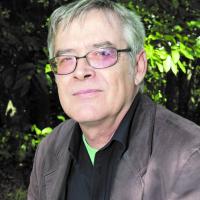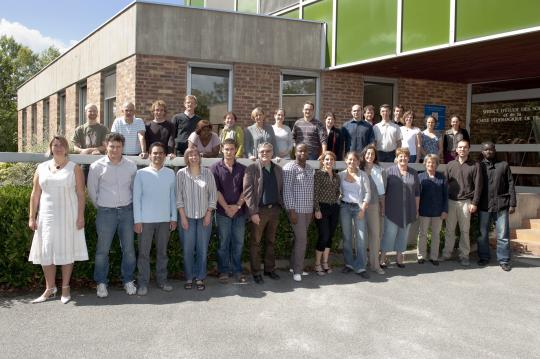
Agroecology Reading time 5 min
Dominique Arrouays, the key to soil management
Published on 10 December 2010
Soil must be viewed as an essential part of mankind's heritage.
"Soils in France aren't in a disastrous state," said Dominique Arrouays. "Nonetheless, there is diffuse contamination from heavy metals like lead, cadmium, and zinc around major urban agglomerations. Our challenge is to find out if soil degradation will worsen or not." Arrouays knows whereof he speaks. The scientist drew his conclusions based on findings of the Soil Quality Measurement Network (Réseau de mesure de la qualité des sols, RMQS), the soil monitoring programme he put in place upon the creation of Infosol. The 13,000 samples used and stored in the large white bins of the National Conservatory of Soil Samples in the Orléans centre were described in detail, from texture and structure to plant nutrients to the presence of pollutants, and more. "We showed that Lindane, an insecticide that has been banned since 1998, is present in all soils, even those where it had not been spread." The scope of the RMQS is astonishing, with the entire French territory divided into 16 sq. km. parcels. This represents 2,200 sites that are visited, sampled, and analysed every ten years. This comes none too soon, though. The British have been carrying out routine soil sampling since 1978, and the importance of soils cannot be overemphasised. Not only are they essential to food production; they are also used to filter pollutants, as biological reserves, or for water or carbon storage. "Soil must be viewed as an essential part of mankind's heritage," argued Dominique Arrouays in his deep voice.
The key to soil management
Like a symphony conductor, Arrouays ties together some one hundred field partners, the GIS Sol (1) , an institutional body that selects scientific programmes, and his own unit which implements those same programmes. The RMQS is one of nine ongoing major national projects. It will be monitored in the long term along with the soil analysis database. The latter makes use of a set of 15 million analyses conducted between 1990 and 2005 by laboratories recognised by the Ministry of Agriculture, in response to requests by farmers who needed to manage soil fertility (soil acidity, organic material content, etc.). An initial summary found that phosphorus (2) content remained relatively poor, contrary to expectations, with the exception of Brittany (livestock farming concentrations) and the Nord-Pas-de-Calais (mining residues).
A landmark project
"At the heart of Infosol lies a collection of gigantic databases that are generated from our projects," explained Arrouays, who was behind the service unit's creation. "Database administrators, statisticians, programmers, and cartographers – about forty persons all told – design and keep the databases updated, and process the data to produce useful maps for our partners." His stint as the French representative for the European Environment Agency's Topic Centre on Soil from 1996 to 1999 prepared him for the colossal endeavour. "I surveyed each EU country's practices in terms of soil mapping and monitoring." Arrouays joined INRA in 1983 as an engineer and pedological cartographer with the Soil Survey Staff – Pedological Map of France unit, where he first coordinated mapping programmes in France's Centre and Aquitaine regions respectively. Today, soil mapping at a scale of 1:250,000 (which makes it possible to view a French département on a Michelin map-type format) is nearly complete thanks to the Survey, Management and Protection of Soils programme (IGCS) coordinated by Infosol. "IGCS is an indispensable decision-making tool," said Pierre Stengel, mission head and former head of the Soil Science Unit at INRA, and Arrouays's close collaborator. "This thousand-project-man was behind the shift from functional mapping to digital predictive mapping for properties such as carbon content, distribution of contaminants, or recycling potential for organic effluents. He is one of the first to combine pedological knowledge, spatial analysis, and modelling." This pioneering spirit was already manifest in 1982, when, as an engineering student in agricultural techniques (3), he chose soil mapping by remote detection as his thesis topic.
International recognition
He not only leads major projects, he is also a major contributor to research programmes," said Stengel. Arrouays won recognition from peers with one of INRA's very first collective scientific expertise reports, which he led from 1999 to 2001, on the topic of carbon storage in French agricultural soils as a possible tool in reducing the greenhouse effect. The issue - a major one in the context of the Kyoto protocol's application - was an extension of his thesis on carbon storage in the Aquitaine soils he had mapped, and for which he was awarded the silver medal of the Académie d'Agriculture in 1994. His expertise lent him a spot as a member of the Intergovernmental Panel on Climate Change (IPCC), which received the Nobel Peace Prize in 2007. "A prize I shared with a thousand scientists," underscored the knowledgeable comic book fan (4). There were only three others who shared the award for best scientific article that he received the following year, though, from the International Union of Soil Sciences!

(1) The Scientific Group about Soils (GIS) comprises INRA, the ADEME, the ministries of Agriculture and Environment, the National Forest Inventory (IFN) and the IRD.
(2) Phosphorus supplementation can improve plant growth, but may contribute to the degradation of surface water in some cases.
(3) École nationale d’ingénieurs des travaux agricoles de Bordeaux.
(4) Soil in comics, one of his talks during the 19th World Congress of Soil Science in Brisbane from 1 to 6 August 2010.
ON WINNING THE AWARD
"They represent the trust and freedom to try things that INRA gave me. This is how staff can live up to their potential; it's not in forcing them to follow straight and narrow paths. I want to thank INRA for the quality of professional life that I enjoyed."
53 years old, two children
Engineer in agricultural techniques from the Ecole nationale d'ingénieurs des travaux agricoles, Bordeaux
Doctor in agronomy, Ecole nationale supérieure agronomique, Montpellier
Awards and distinctions:
- Member of the Intergovernmental Panel on Climate Change, 2007 Nobel Peace Prize laureate;
- Best scientific article 2008 awarded by the Pedometrics commission of the International Union of Soil Sciences
Hobbies: Comic books
